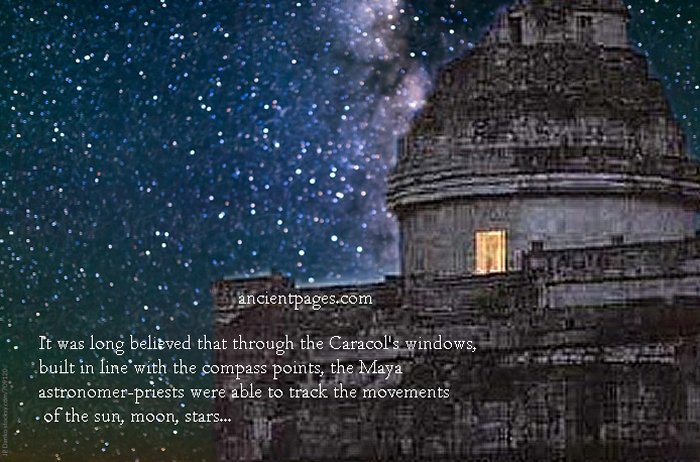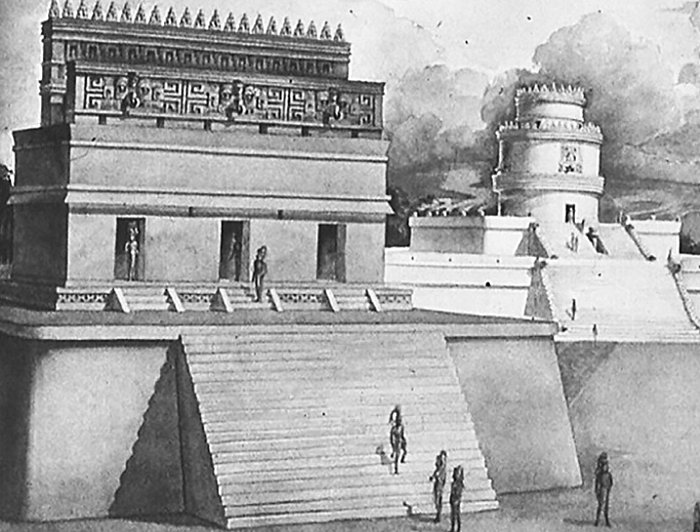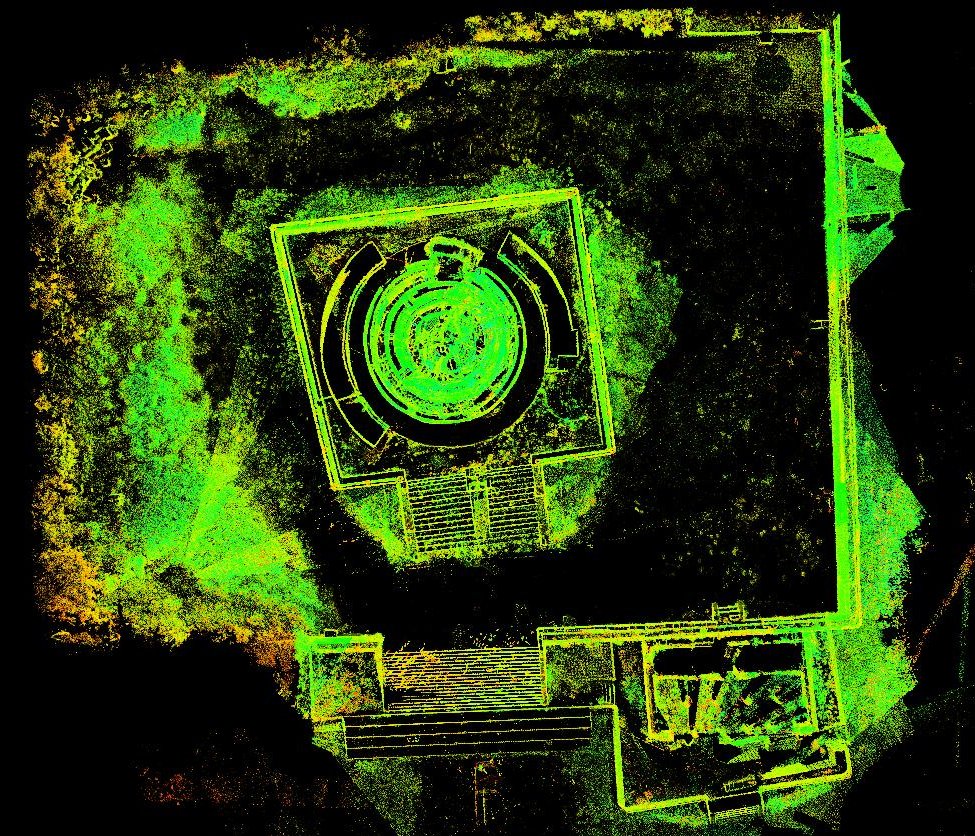Mysterious El Caracol At Chichen Itza: What Did Maya Astronomer-Priests Observe In The Sky?
A. Sutherland - AncientPages.com - Ancient astronomical observatories can be found on both American continents and elsewhere. Ancient people who built ziggurats, temples, and observatories, aligned them to exact celestial orientations and carefully observed the sky, understood celestial movements, cycles of the moon, sun, stars.
The Aztecs worshiped the Pleiades, and the Maya had a cult of Venus ("the morning star"). Despite the lack of advanced technology, the Mayans were great astronomers. Their observations were so accurate that they could predict solar and moon eclipses, describe the movement of planets in the solar system and create very precise calendars.
A Mayan pyramid, El Castillo, has windows in the top of the pyramid, aligned with sunrises at the solstices and alignments with the sunset points of the equinoxes.
It is located in the pre-Columbian city of Chichen Itza, one of the most famous Maya cities, which – like Uxmal - flourished around 800 AD. However, Chichen Itza still had its influence while other Mayan cities were abandoned and ruined.
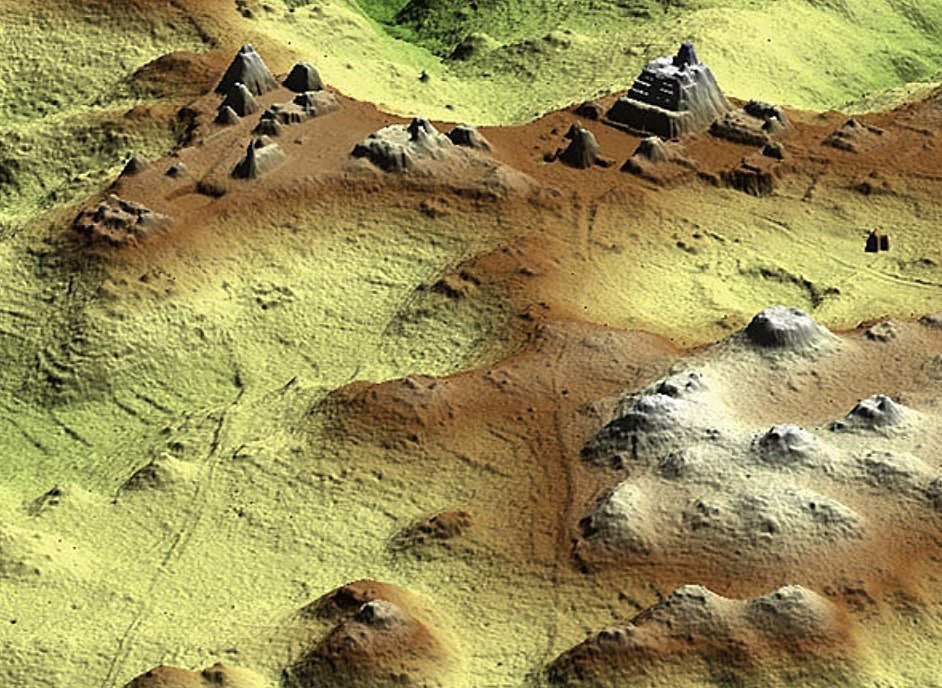 A 2.5 D LiDAR image of the Caracol epicenter looking northwest. Source www.caracol.org
A 2.5 D LiDAR image of the Caracol epicenter looking northwest. Source www.caracol.org
Also at Chichen Itza, there is another example of advanced Mesoamerican astronomy of old times. It is the 74-foot high building nicknamed ‘El Caracol’ ("Snail"), which is believed to be an ancient observatory.
Its name refers to the spiral shape of the stairs (leading to the top of the observatory) and located inside the El Caracol’s circular tower, with orientations intentionally designed to mark important alignments with Sun and planet Venus (recorded in the Dresden Codex), and the setting sun at the equinox.
There is the solstice diagonal of the upper platform, the zenith passage sunset, and the Venus northernmost setting.
It is known that El Caracol was a monument related to Kukulcan (Quetzalcoatl), who in the 9th-century texts at Chichen Itza was never identified as human and artistic representations depicted him as a ‘Vision Serpent’ entwined around the figures of nobles.
Not much more it is known for sure about El Caracol's ancient past. Many researchers have speculated on the purpose of the structure and its precise function.
It was long believed that through the windows, built-in line with the compass points, the Maya astronomer-priests were able to track the movements of the sun, moon, and stars. Many windows of El Caracol are located so that they allow observation of certain phenomena in the sky, such as the setting sun during the spring equinox.
Indeed, the structure looks like an observatory, but there is no ancient evidence attesting its use.
“… while stellar observations might have been important, there are too many possibilities – too many bright stars – to place much credence on any apparent stellar alignments that have been found.” (Clive L.N. Ruggles, Ancient Astronomy).
The Caracol Tower seen from the Casa Colorada. (T. Proskouriakoff, 1946, An Album of Maya Architecture)
The two of the three surviving windows were perfectly placed for observing Venus; however, the Maya also focused much on observations of the Moon and what else? From the top of the prehistoric El Caracol, the whole sky is clearly seen, because it is not covered by other buildings or trees of the lush forest growing on the Yucatán peninsula.
“The most probably the mysterious Caracol had nothing to do with astronomical observations at all…” according to Ruggles.
Composite 3D laser scan image of El Caracol from above. Image credit: CyArk - CC BY-SA 3.0
Or perhaps it was designed to study a multitude of astronomical phenomena, including the Moon and, especially, Venus.
Did Ancient Maya Farmers Need Sophisticated Caracol For Agricultural Activities?
Apparently, they did not. “… a simple sun clock, a gnomon, would suffice to provide enough daily and seasonal information,” Zecharia Sitchin writes in his book “The Lost Realms,”
“It is customary among scholars to attribute ancient man's astronomical endeavors to the needs of an agricultural society for a calendar telling it when to sow and when to reap. This explanation has been taken for granted far too long. A farmer tilling the land year after year can judge the change of seasons and the coming of rains better than an astronomer…”
According to Sitchin, primitive societies surviving on agriculture have been found in remote parts of the world. The fact remains that these people have lived and fed themselves for generations without astronomers and a precise calendar.
Written by – A. Sutherland - AncientPages.com Senior Staff Writer
Copyright © AncientPages.com All rights reserved. This material may not be published, broadcast, rewritten or redistributed in whole or part without the express written permission of AncientPages.com
Expand for referencesMore From Ancient Pages
-
 2,500-Year-Old Phoenician Shipwreck Being Rescued By Archaeologists
Archaeology | Jul 4, 2023
2,500-Year-Old Phoenician Shipwreck Being Rescued By Archaeologists
Archaeology | Jul 4, 2023 -
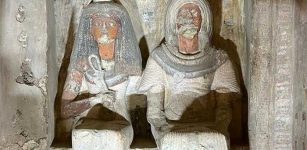 Look Inside The Amazing Egyptian Tomb Of Scribe Neferhotep In Luxor
Places | Feb 19, 2024
Look Inside The Amazing Egyptian Tomb Of Scribe Neferhotep In Luxor
Places | Feb 19, 2024 -
 Norse Kingdom Of Dublin Was Founded By The Vikings In 839 A.D.
Ancient History Facts | Mar 15, 2016
Norse Kingdom Of Dublin Was Founded By The Vikings In 839 A.D.
Ancient History Facts | Mar 15, 2016 -
 North America’s Oldest Known Pterosaur – Discovered
Paleontology | Jul 10, 2025
North America’s Oldest Known Pterosaur – Discovered
Paleontology | Jul 10, 2025 -
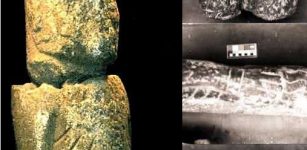 Inscription On Pokotia Monolith Reveals Sumerians Visited Peru Thousands Of Years Ago
Ancient Symbols | Sep 1, 2015
Inscription On Pokotia Monolith Reveals Sumerians Visited Peru Thousands Of Years Ago
Ancient Symbols | Sep 1, 2015 -
 Middle Iron Age And Roman Period Buildings And Relics Discovered In Bedfordshire, UK
Archaeology | Feb 27, 2022
Middle Iron Age And Roman Period Buildings And Relics Discovered In Bedfordshire, UK
Archaeology | Feb 27, 2022 -
 Did Richard The Lionheart Order Assassins To Kill Conrad Of Montferrat, King Of Jerusalem?
Featured Stories | Dec 27, 2018
Did Richard The Lionheart Order Assassins To Kill Conrad Of Montferrat, King Of Jerusalem?
Featured Stories | Dec 27, 2018 -
 Ancient Human Traces Found In The Inhospitable Namib Desert
Human Beginnings | Oct 21, 2024
Ancient Human Traces Found In The Inhospitable Namib Desert
Human Beginnings | Oct 21, 2024 -
 Controversial Prehistoric Bronze Gears Of Peru
Artifacts | Aug 15, 2015
Controversial Prehistoric Bronze Gears Of Peru
Artifacts | Aug 15, 2015 -
 Mystery Of Vangchhia Ancient Site: Water Pavilion And Ingenious Idea Of Water Harvesting
Archaeology | Feb 21, 2019
Mystery Of Vangchhia Ancient Site: Water Pavilion And Ingenious Idea Of Water Harvesting
Archaeology | Feb 21, 2019 -
 Nail Polish Was Used In 3,000 B.C. – Color Of Fingernails Indicated Social Status In Ancient China And Egypt
Ancient History Facts | Jan 11, 2018
Nail Polish Was Used In 3,000 B.C. – Color Of Fingernails Indicated Social Status In Ancient China And Egypt
Ancient History Facts | Jan 11, 2018 -
 Cacao Was Cultivated By Cultures Along The Pacific Coast Around 5,000 Years Ago – New Study
Archaeology | Mar 7, 2024
Cacao Was Cultivated By Cultures Along The Pacific Coast Around 5,000 Years Ago – New Study
Archaeology | Mar 7, 2024 -
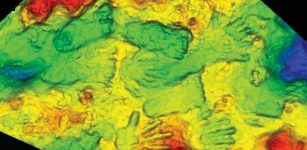 World’s Oldest Hand And Footprints Discovered On The Tibetan Plateau Are 226,000-Year-Old!
Archaeology | Sep 15, 2021
World’s Oldest Hand And Footprints Discovered On The Tibetan Plateau Are 226,000-Year-Old!
Archaeology | Sep 15, 2021 -
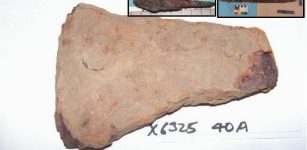 Spearheads – The Chemical Fingerprint Of Viking Weapons – New Study
Archaeology | Feb 18, 2022
Spearheads – The Chemical Fingerprint Of Viking Weapons – New Study
Archaeology | Feb 18, 2022 -
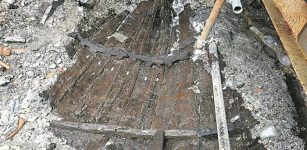 Ancient Roman Wooden Sewn Boat Unearthed In Croatia
Archaeology | May 3, 2020
Ancient Roman Wooden Sewn Boat Unearthed In Croatia
Archaeology | May 3, 2020 -
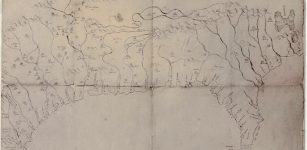 Cartography Shows That The Isthmus Of Tehuantepec Was Used As An Inter-Oceanic Passage In The 16th Century
Archaeology | Oct 21, 2022
Cartography Shows That The Isthmus Of Tehuantepec Was Used As An Inter-Oceanic Passage In The 16th Century
Archaeology | Oct 21, 2022 -
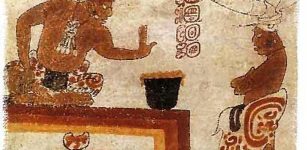 Chocolate Was Invented In Mesoamerica 1900 B.C.
Ancient History Facts | Jan 17, 2016
Chocolate Was Invented In Mesoamerica 1900 B.C.
Ancient History Facts | Jan 17, 2016 -
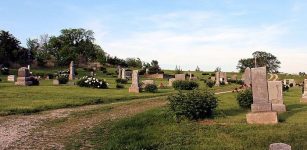 Mystery Of The Stull Cemetery: A Gateway To Hell?
Featured Stories | Aug 25, 2018
Mystery Of The Stull Cemetery: A Gateway To Hell?
Featured Stories | Aug 25, 2018 -
 Does A Baffling Artifact Offer Evidence Of Ancient Extraterrestrial Visitation In New Zealand? – The Discovery – Part 1
Ancient Mysteries | Jul 20, 2020
Does A Baffling Artifact Offer Evidence Of Ancient Extraterrestrial Visitation In New Zealand? – The Discovery – Part 1
Ancient Mysteries | Jul 20, 2020 -
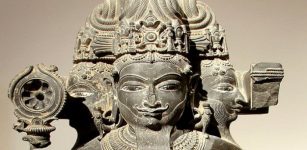 Brahma: First God In Hindu Trimurti, Creator Of The World And All Creatures
Featured Stories | Apr 17, 2019
Brahma: First God In Hindu Trimurti, Creator Of The World And All Creatures
Featured Stories | Apr 17, 2019

